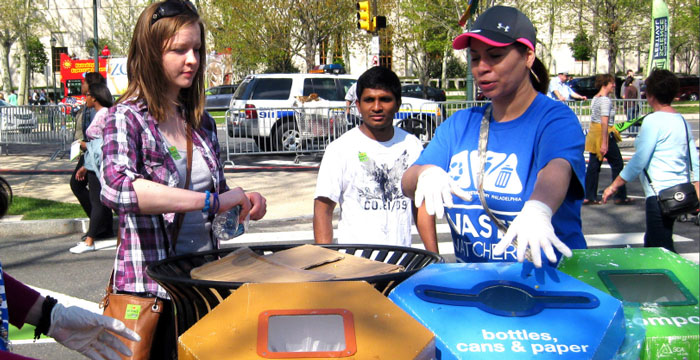
Zero Waste & Litter Action Plan: How “Philly-Centric” Roadmap Tackles Waste
With a long history of being dirty, Philly admits that we have work to do to be considered a “sustainable city.”
Since 1960, the amount of municipal solid waste has nearly tripled, and only 89 million tons of waste is recycled or composted (compared to 136 million tons to the landfill.) Plus, we recently pledged to meet Paris climate agreement standards. To compete with the ranks of major and sustainable US cities like New York, LA, and Atlanta, Philadelphia created Zero Waste goals.
We chatted with Nic Esposito back in March about why the Zero Waste and Litter Cabinet was formed and ambitious goals of diverting 90% of waste from Philly landfills by 2035. Today, the comprehensive Zero Waste and Litter Action Plan was officially released on the Clean PHL website.
After reviewing other cities Zero Waste plans, Esposito stressed the importance to make this a “Philly-centric” plan. “We have to realize how much we can afford as a city. We have less tax-base than a city like New York. Or how Philly is a dense city (compared to Denver with bigger yards.)”
Philadelphia Zero Waste & Litter Action Plan released
Zero Waste and Litter Director, Nic Esposito, stressed the readability and accessibility of the document. Similar to the latest iteration of the Greenworks Philadelphia plan, the plan is a guiding document both for the city and residents to use to work together. “People from the city, anyone, can read and understand this document,” as Esposito said.
The work of this plan was a result of interdepartmental collaboration including the Streets Department, with stakeholders like Streets Commissioner Calton Wiliams supporting the initiatives.
After meeting every 1-2 months, the Zero Waste and Litter cabinet worked with city stakeholders (SEPTA, City Council, PennDOT, DA’s Office, community partners, etc.) to create this robust document. Five subcommittees tackled different aspects (Zero Waste, Litter Enforcement & Cleaner Public Spaces, Data, Behavioral Science, Communications & Engagement) of the plan.
Creating idealistic goals for sustainability is easy. But the Zero Waste plan was designed with realistic goals that people can understand. “We’re pulling the curtain back a little bit on city government;” Esposito mentioned they ran pieces of the plan with the following theoretical questions:
“Can we do it?” Will it work?” “Is it worth it?”
Considering each piece of the plan also helped buy-in among stakeholders.
Zero starts with One: How You Play a Role in Zero Waste
“Government can do this, but we do need residents to think about their waste a little bit more.” – Nic Esposito
What can the city do versus what the residents can do?
Esposito acknowledges that although the city has to help facilitate access to these goals, residents play an important part. Expanding access to sanitation convenience centers will allow people to get specialized recycling from their curbs to one centralized place. Whether light bulbs or batteries or tires, products can be recycled properly.
The Biggest Step Towards Zero Waste You Can Take
But zero waste won’t happen without everyone in the city. As Esposito says, “We won’t hit zero waste when the streets look the way they look.”
Esposito stresses the importance of consumer decisions, like composting, washing your dishes instead of using disposables or buying products with less packaging to reduce waste on the front-end.
Recycling correctly is a huge first step towards zero waste. People often “wishcycle,” throwing things in their recycling bin because they want to do good, but it contributes to cross-contamination instead.
Esposito knows reducing waste isn’t impossible. Each week, he sets out one bin of recycling and one bin with a single trash bag (even their family, including a three-year old! Parents – you can do it.) “If everyone in the city could put their waste out nice and neatly, not overflowing, that would be huge.”
When you’re cleaning up in front of your house, focus on how you can help fight litter in the plan, too.
Photos: CleanPHL.org






